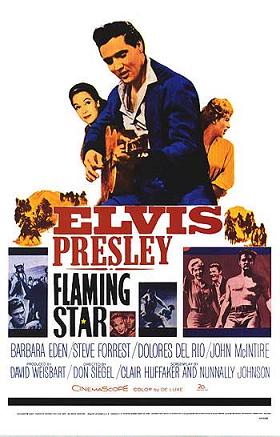
FLAMING STAR
US, 1960, 90 minutes, Colour.
Elvis Presley, Steve Forrest, Dolores Del Rio, John Mc Intyre, Barbara Eden.
Directed by Don Siegel.
Flaming Star has Elvis singing the title number and soon singing another song, and there any resemblance between this and the usual Presley film ceases. This is a good Western, exciting, well-acted, harsh but with some feeling for the plight of half-white, half-Indian breed. It is directed by Don Siegel (The Killers, Madigan, Coogan's Bluff, Two Mules for Sister Sara, The Beguiled), a director admired by French cinema academics for his tough, terse style.
Presley is good - especially compared with his wooden Western, Charro (1969) and the supporting cast acts well. There is a harsh atmosphere about the film reflecting the questions the film raises.
An unusual and successful Western.
1. The film began as a fairly typical Presley-style movie and quickly changed. When did the change take place? Were you ready for it?
2. Were you impressed by the film's presentation of its racial hatred and distrust theme? How did the film evoke sympathy for the half-Indian? What impression did the family make on you ? their unity, friendliness? The Indian mother?
3. "The woman who deserted her own people". The Indians say this of the mother. How does it summarise the feeling of the half-breed in a no-man’s-land of unacceptance by red and white?
4. Modern race questions often focus on land rights ? the early race being displaced by the new settlers and the consequent struggle for land. What was the land situation in the film? What were the rights and wrongs on both sides?
5. The family decided that on this frontier they would have to be a power unto themselves, resisting those who broke the laws of God and man. What was the basis of law on the frontier? How much did hatred and revenge for killing influence moral action? Were these people especially Clint and Pesa too ready with their guns?
6. The Indians rob, raid and burn; the whites are prepared to raid and burn those they disagree with. How does the film show there is little difference between red and white in #meanness'?
7. Discuss the scene where the trappers treat Pesa as 'boy' and accost his mother. What is the purpose of the sequence?
8. There is an irony in the death of the parents. The mother saw a figure in the hills and wanted to help him; this was the man who shot her. The father is killed by Indians. This is pessimistic irony. Is the film pessimistic?
9. Did Pesa make a reasonable choice in joining the marauding Indians?
10. How did the wounding of his brother and the death of his father settle Pesa's view of life and make him wish for death?
11. Death seemed to be the only solution to the problems posed in the film, almost a fatalism of the seeing of the flaming star of death. Could the Indians of last century have seen things from any other point of view?